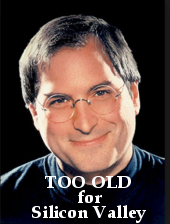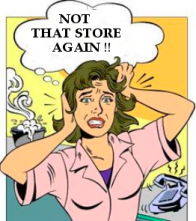Experience – a Silicon Valley Opportunity
By · CommentsWhy does Silicon Valley ignore people based on age?
Go into any creative industry (such as a startup or an advertising agency) and it is absolutely impossible to find anyone over the age of 40. And yet, in many creative fields, older people completely dominate.
- Steve Jobs reinvented industries from age 21 thru 56 and the world would agree that he would still be surprising us with his creativity today if he was still with us at age 60
- Albert Einstein was working on the Manhattan project at age 61
- Thomas Edison filed for more than 200 patents between 60 to 73.
- Andy Bechtolsheim was the first investor in Google, age 54
- The average age of the five Best Director Oscar nominees is 62.
- The Pulitzer Prize for Fiction went to Jennifer Egan, age 50
- The Pulitzer Prize for Drama was awarded to Bruce Norris, age 52
- The Noble Prize for Literature went to Tomas Transtromer age 83.
- The Emmy for Best Comedy went to Modern Family creators Christopher Lloyd, age 52 and Steven Levitan, age 50
And I am sure that NONE of these people would get an investment, or be hired by ANY company in Silicon Valley. Dan Sheinman (the original investor in VMWare) is one of the only exceptions to the Silicon Valley bias. He says “Older entrepreneurs are the mother of all undervalued opportunities.“
The GeoHelp web site is where customers can safely follow local brick & mortar businesses. Unlike ALL traditional social / advertising platforms, GeoHelp lets you control your communications, and we do not share your private information.
1) RELEVANT NEWS: What if you could get information about a new product delivery, or an upcoming sale, or an event discount ? Or become familiar with the REAL PEOPLE behind the brands that you enjoy.
2) QUESTIONS & ANSWERS: The GeoHelp app lets you get answers to your questions using your mobile phone. Businesses can answer questions such as “Do you carry Gucci sunglasses?” or “Are Goodyear tires better than Firestone?”. These real-time questions (and more) from ALL of their customers are visible for you to read. So a type of business specific “chat session” gives you much more information about that business.
For example: When you are hungry, you can look at the business’s GeoHelp Community as see questions and answers from many customers. To ask your own question, just write a text message (or use our voice entry).
To follow a favorite business, just use the Business FOLLOW checkbox !
The GeoHelp by 2du® platform lets you choose EXACTLY what companies you are interested in communicating with (or receiving info and specials from). The directory is international and can be sorted by name, distance, city, and more.
Just Like Max & 99… Mobile Consumers Want Control
By · CommentsNew research by the consumer research company Communispace (http://communispace.com) shows that connected consumers want control over the cadence and content of messages sent to their mobile phones.  This conclusion is contained within a report entitled “Connecting with the Connected Consumer” which is the exact opposite of what is currently being done by most mobile marketers. I know of very few brands that give their customers a way to express their preferences and give them the ability to edit or modify how they are contacted.
This conclusion is contained within a report entitled “Connecting with the Connected Consumer” which is the exact opposite of what is currently being done by most mobile marketers. I know of very few brands that give their customers a way to express their preferences and give them the ability to edit or modify how they are contacted.
Other conclusions in the study were:
1) Companies MUST respect the privacy of consumers. Treat people like you would want to be treated. Instead of YOU tracking your customers, why not enable customers to track you!
2) Offer something of value - Mobile consumers are ready and waiting for contact with familiar brands on mobile devices; awareness and willingness is there, but few brands have cracked the code for providing consistent value via mobile technologies.
3) Hand over the reins – Mobile users want control over when, where, how, and how often they interact with brands on mobile platforms — the more personalized, the better.
4) Create custom, relevant experiences – Untargeted and irrelevant content will be shunned by mobile consumers. Specialized, personalized and exclusive rewards suggest an aptitude for giving customers what they need and want.
As a part of our GeoHelp Platform, we included a USER PORTAL FOR EVERY CUSTOMER so everyone can control how they are contacted, and when it is ok to contact them. Our system gives businesses the ability to send relevant information and rewards IMMEDIATELY to customers at the exact time when they want to engage. Perhaps adding customer control portals might be the secret to creating a lasting relationship with your connected “followers” ?
Mobile Marketing’S Guidelines – Respect Your Customers
By · CommentsIf you are a retailer considering a move into mobile marketing, or you’re a marketer trying to nudge that retailer, you may be battling a perception that MM is the equivalent of that obnoxious telemarketing call that happens precisely when your family sits down to dinner. Won’t people get tired of your message program…like, quickly?
The answer is yes…if you’re obnoxious about it. But, what does that mean, exactly? How much is too much? Are there any standards to go by? Actually, there are, as provided by the Mobile Marketing Association.
The six “C”s of an Ethical Mobile Marketing Program
These correct way to do mobile marketing is to offer customers:
- Choice - Your consumer has a right to privacy, and must first “opt-in” to a mobile marketing program.
- Control - Consumers should have control of when and how they receive your message, and be able to easily terminate or “opt-out” when they choose.
- Customization - You should tailor your message to reflect the data and preferences supplied by your consumer. This results in more useful messages and less spam!
- Consideration – You should offer your consumer something of perceived value in return for receiving your message.
- Constraint – You must manage and limit mobile messaging to a reasonable number of programs.
- Confidentiality – You shouldn’t share consumer information with non-affiliated third parties.
In the end, these six “C”s boil down to one thing… treating your customers with respect. It takes talent to strike the balance between a prominent, effective message…and obnoxiousness. At 2du, there were a LOT of design decisions that went into trying to protect the concept of the six “C”s… we are trying our best.
Entrepreneurs – Opportunities and Executing Your Vision
By · CommentsHow does one turn good ideas into successful corporations ? A large number of entrepreneurs start this path every year and become a significant percentage of the world economy. The existence of entrepreneurs such as Bill Gates, Steve Jobs, and Richard Branson are known, but do people really understand what they accomplished ? Does the “man on the street” really realize what it takes to go from working 20 hour days in a garage (surrounded by old pizza boxes) to being the richest man in the world ? Their riches were not due to ancestry, they were not due to conquest, they were not because they owned natural resources. This great wealth was due to the creation and execution of a GOOD IDEA !
Note the sentence above… creation and EXECUTION. Executing on an idea requires that you first create a vision of the future. What is your goal ? How big will your company be ? What markets will you be in ? What problem categories will you be solving ? What environmental factors will be affecting your business in the future? This vision should not be a straight-jacket though… this is based on information that you have right now… as you get more information, your vision can change… but at ALL TIMES, you must know what the end game is or you don’t know what steps are needed to get there.
With my 2du company, I have a pretty aggressive “vision”. The reason that I think this is attainable is primarily due to my opinions concerning the future of new media technologies. I think we are in the first phase of a “perfect storm” where a combination of events are going to dramatically change the way that businesses communicate and create value for their customers. Radical changes are happening all around us… sales, marketing, and support techniques, the ways that we pay for goods and services, the visibility and power of individual opinion, and more… all of these are being enabled by NEW MEDIA technologies. I think this is a business tsunami that will effect ALL business (world-wide) ! This is NOT a niche, this is ALL business (world-wide). Think about it… I can’t even say what that dollar value is or people will just roll their eyes ! I really do believe that new media technologies will be purchased and integrated into EVERY business in the coming years. The NEW MEDIA opportunity is one of those situations like the early days of electricity… very few people have it and EVERYONE needs to be connected !
As long as we execute our WIN-WIN ideas… well…. I better get back to work !!
Browsing through the RSS feeds today and I see an article about a “press court” ruling in UK… it seems that an employee of the Department of Transport made some comments about “not liking her job” and she was “nursing a hangover” at work… well… it is not unusual to hear these things in face-to-face conversations but when they are on twitter it just might be tomorrow’s headline !
“Worker Confession – Trains are unsafe !” could have been the headline from those “minor comments” in a public social medium. Well, that doesn’t sound fair, isn’t there some way to stop journalists from using your tweets in their stories ? “I was just tweeting to my followers” sounds like a good defense in court, but this “press court” in UK made the following ruling:
“In reaching its decision on the case, the Commission judged that the publicly accessible nature of the information was a “key consideration”. It was quite clear that the potential audience for the information was actually much larger than the 700 people who followed the complainant directly, not least because any message could easily be retweeted to a wider audience.”
To her credit, she had included a clear disclaimer on her Twitter feed that the views expressed there were personal, and were not representative of her employer but the court still ruled that one can reasonably assume that this information will become public ! Ahhh… reminds me of the wiki-leaks case as well !
So in conclusion, if you are in a PUBLIC FORUM then you are speaking PUBLICLY. Your only alternative is to participate in a forum that both implements technical security measures and states that the purpose of your account is to conduct PRIVATE CONVERSATIONS with followers. These exist !
Click here to read the entire PCC ruling article.
 The latest buzz word in retail is “
The latest buzz word in retail is “ OK… bear with me here… this might get a bit technical, but I think I can explain this in a way so everyone can understand what GRAVITY and MOBILE PHONES have to do with each other !
OK… bear with me here… this might get a bit technical, but I think I can explain this in a way so everyone can understand what GRAVITY and MOBILE PHONES have to do with each other !




